Georgios Panagopoulos MD | Orthopaedic Surgeon

Table of contents
What's a distal radius fracture?
A broken wrist is a break or crack in one of the bones of your wrist. This is usually a distal radius fracture. A wrist fracture commonly happens after an awkward fall on the outstretched hand. It is important to treat a broken wrist promptly to prevent stiffness, pain and permanent deformity.
Fracture types
There are many types of wrist fractures. A dorsally displaced, extra-articular fracture of the distal radius is the most common type, and it is known as a Colles fracture. A volubly displaced fracture is often called a Smith's fracture. Intra-articular fractures are also common (ie, Barton's fractures).
Causes
The most common cause of a broken wrist is a fall on the outstretched hand. This is one of the most common fractures related to osteoporosis in people > 65 years of age, second in line after hip fractures. Wrist fractures also occur during sports that involve frequent falls, such as snowboarding or skating, as well as contact sports. They can be a consequence of car accidents, that can result in very comminuted and challenging fractures.
Symptoms
Symptoms of a distal radius fracture may include:
- Severe pain after the injury
- Swelling and bruising of the wrist
- Obvious deformity of the wrist
- Numbness and tingling, if your nerve is bruised
Diagnosis
The doctor will take a detailed history and examine you carefully. An x-ray is usually sufficient to confirm the diagnosis. If your wrist is crooked, the doctor may attempt to set it straight under sedation. A repeat x-ray may be ordered to check if the reduction was successful, and your wrist is now in an acceptable position. You will be typically referred for further treatment to an orthopaedic surgeon. The surgeon may request a CT scan for preoperative planning.
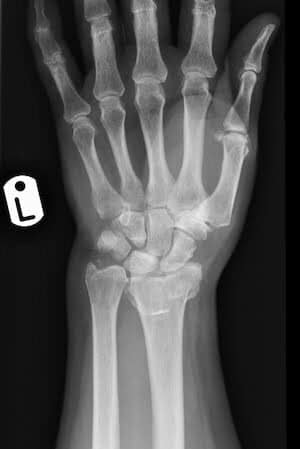
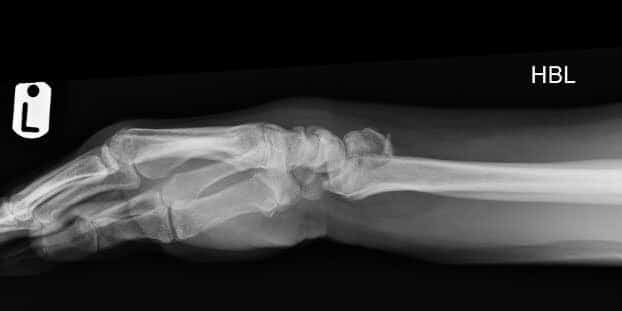
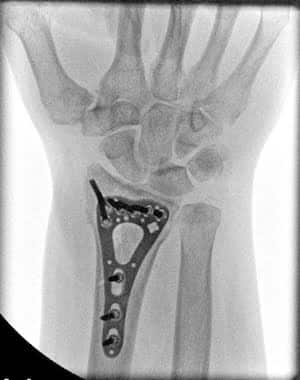
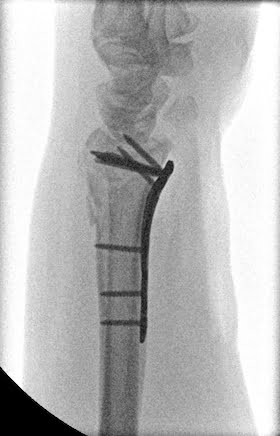
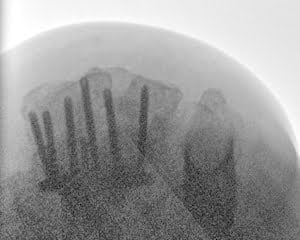
Treatment
Most distal radius fractures can be treated conservatively, if an acceptable position is obtained after closed reduction. The wrist is then placed in a splint or cast, and the fracture is followed radiographically, until bone healing is appreciated.
The cast is usually maintained for a period of 4 weeks, after which a removable brace can be used instead for safety and support. After cast removal, the patient follows an individualised rehabilitation program, in order to regain dexterity and avoid stiffness.
Some wrist fractures, however, are considered unstable and require surgery. These include fractures with intra-articular involvement, open fractures, or fractures with residual or secondary displacement after closed reduction.
Surgery is typically done under general anaesthetic +/- nerve block and involves the use of a plate and screws in most situations. After surgery, you may be placed in a removable brace or a splint. You will be encouraged to move your fingers, elbow and shoulder in order to avoid stiffness. Early mobilization of the wrist is also encouraged, unless the surgeon is worried about the fixation being tenuous. Your surgeon will follow up with serial x-rays until they are satisfied with bone healing.
Dr Panagopoulos has extensive experience in the treatment of wrist fractures, and will discuss with you all options during your visit in our office.
FAQs - Frequently Asked Questions
What's a distal radius fracture, or broken wrist?
A broken wrist is a break or crack in one of the bones of your wrist. This is usually a distal radius fracture.
What causes a wrist fracture?
A wrist fracture commonly happens after an awkward fall on the outstretched hand.
What are the symptoms?
– Pain
– Swelling & bruising
– Obvious deformity
– Numbness & tingling
How is diagnosis made?
– History & clinical exam
– Ακτινογραφίες
– Αξονική τομογραφία
What's the treatment?
Most fractures are amenable to conservative management in a splint or cast. In more severe cases, you may need surgery.
Wrist fracture & casting duration
The cast is usually maintained for a period of 4 weeks, after which a removable brace can be used instead for safety and support.
Find us
Book an appointment with us today
